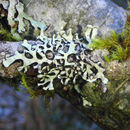Comprehensive Description
provided by Smithsonian Contributions to Botany
Hypotrachyna sinuosa
Lichen sinuosus Smith, 1809:2050. [Type collection: Dumfriesshire, England, Burgess (LINN, lectotype).]
Parmelia sinuosa (Smith) Acharius: 1814:207.
Parmelia despreauxii Delise ex Duby, 1830:602. [Type collection: Vire, France, Despreaux and Briquebec (not seen).]
Parmelia sinuosa var. virescens Kremplehuber, 1861:131. [Type collection: Mittenwald, Germany, Krempelhuber (M, lectotype; UPS, isolectotype).]
Parmelia meyeri Zahlbruckner, 1905:82. [Type collection: Chimborazo, Ecuador, Meyer 365 (W, lectotype).]
Thallus adnate to loosely adnate on bark and twigs, rarely on rock, sometimes suberect at the periphery, pale greenish yellow, 2–7 cm broad; lobes sublinear, short, 0.7–3 mm wide; upper surface plane, continuous, sorediate, less commonly pustulate-sorediate, the soralia capitate, orbicular to diffuse, subterminal; lower surface densely rhizinate, the rhizines sometimes forming a marginal mat. Apothecia very rare, adnate, 1–4 mm in diameter; spores 7μ–9μ × 10μ–14μ.
CHEMISTRY.—Cortex K−, medulla K+ yellow turning red, P+ orange (usnic acid and salacinic acid, sometimes with norstictic acid and a trace of stictic acid).
DISTRIBUTION.—Alaska to Oregon, southeastern United States, Mexico, West Indies, Andean region from Venezuela to Chile, Europe, southeastern Asia from southern Japan to Java.
HABITATS.—On trees (hardwoods and conifers) and rarely rocks and on small shrubs in the paramo at 2000–3500 m (to near sea level in boreal areas).
- bibliographic citation
- Hale, Mason E., Jr. 1975. "A Revision of the Lichen Genus Hypotrachyna (Parmeliaceae) in Tropical America." Smithsonian Contributions to Botany. 1-73. https://doi.org/10.5479/si.0081024X.25

